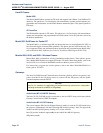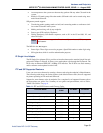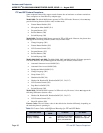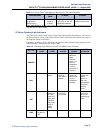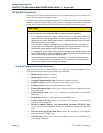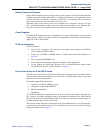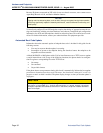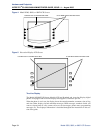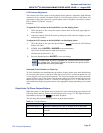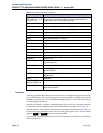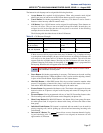
Hardware and Endpoints
INTER-TEL
®
CS-5200/5400 ADMINISTRATOR GUIDE, ISSUE 1.1 – August 2005
Page 90 ITP and SIP Connectivity
ITP and SIP Connectivity
Phones using ITP mode and SIP mode allow users to communicate using the Local Area Net-
work (LAN) and the public telephone system.
IP and SIP calls can be routed through the Inter-Tel CS-5200/5400 or they can be configured as
members of the same Network Group. If the phones are configured as members of a Network
Group, they can use the Peer-to-Peer (P2P) audio feature, which is explained on page 91.
IP and SIP Endpoint Ports and Connectors
The ports and connectors on IP and SIP phones vary depending on the model number. The fol-
lowing ports and connectors may be included on your endpoint:
• Headset Jack: Connects to a headset.
• Handset Jack: Connects to a handset.
• Combined Headset/Handset Jack: Connects to a headset or handset.
• LAN/Power Jack: Connects to an external power supply (see page 91)
• LAN/Power Jack: Connects to a network hub or a switch
• External Microphone Jack: Allows you to connect an external microphone to the end-
point. (8690 only)
• External Speaker Jack: Allows you to connect an external speaker to the endpoint
(8690 only)
• Reset Button: Resets the connection to the network (8690 only)
• Compact Flash (CF) Port: Allows you to connect a CF memory card if additional
memory is needed (8690 only)
• Personal Computer Memory Card International Association (PCMCIA) Port:
Allows you to connect a PCMCIA memory card if additional memory is needed (8690
only)
• Universal Serial Bus (USB) Client Port: Connects the endpoint to a host computer
running ActiveSync
®
(8690 only).
• USB Host Port: Allows you to connect a keyboard, mouse, or other USB device to
your endpoint (8690 only)
CAUTION
Possible Delay in Local Emergency Response to Remote Sites.
IP and SIP phone users should be alerted to the following hazardous situations:
• If an Emergency Call phone number is dialed from an IP or SIP phone located at a
remote site that is not equipped with a correctly configured gateway, the call will be
placed from the location where system chassis is installed rather than from the location
where the emergency call is made.
In this situation, emergency responders may be dispatched to the wrong location. To
minimize the risk of remote site users misdirecting emergency responders, Inter-Tel
recommends regular testing of MGCP/SIP gateway trunk(s) for dial tone.
• If uninterruptible power supply (UPS) protection has not been installed as part of the
Inter-Tel 5000 system, IP and SIP endpoints will not operate when electrical power fails
either at remote sites or at the main system location.
To place calls during a power failure in this situation, IP and SIP endpoint users can
only use a single line phone connected to one of the system’s power failure bypass
circuits or a local phone not connected to the system.



